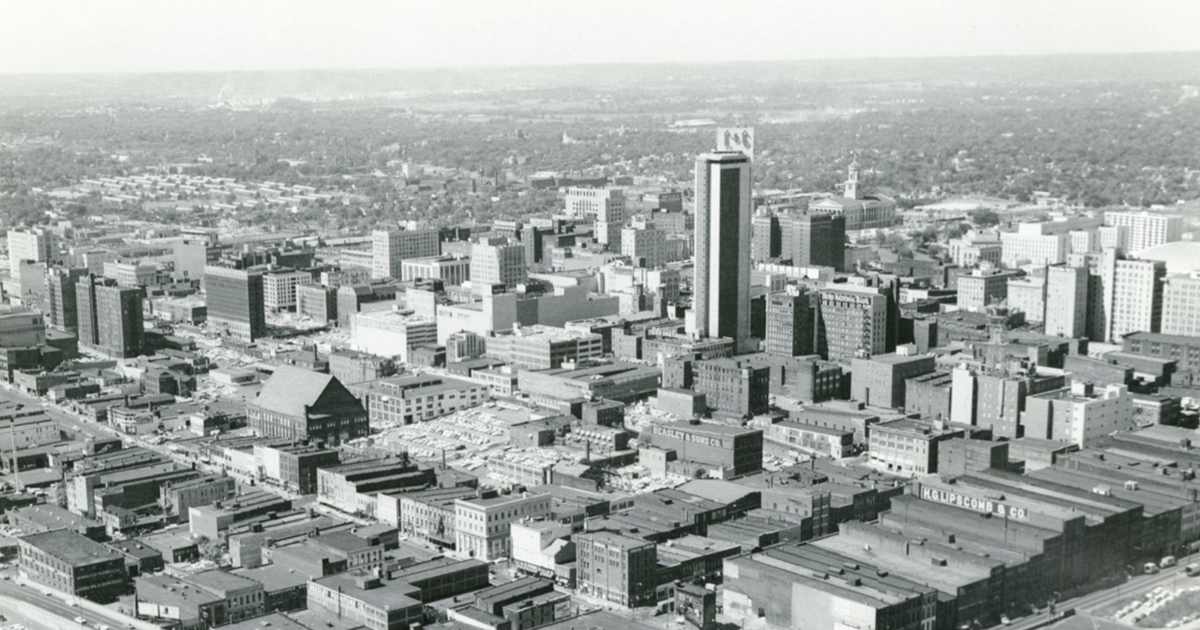Nashville’s Iconic Skyline: A Journey Through Time
Dive into Nashville’s past, present, and future from a developmental standpoint. Where has the Nashville skyline been and — perhaps more crucial for today’s residents, workers, and tourists — where is it headed?
Click one of the links below to start exploring.
Nashville Over the Years: A Development Story
In the modern day, Nashville is one of the top targets for commercial real estate investors — and it gets that position honestly.
In the 1950s, Music City was already a hub for rhythmic creatives, but it was also a central location for banks, insurance companies, and key country music publishers.
Nashville in the 1950s and 1960s

Nashville first dove back into development after World War II’s end with the Life & Casualty Tower, then the home of the Life & Casualty Insurance Company, built from 1956–1957 by Foster & Creighton. While it still wears the L&C emblems with pride, it’s now the home of companies like Warby Parker and Complex Media.
At the time of its construction, the L&C Building towered over what was Nashville’s first skyscraper, the J.C. Bradford Building, which is now home to the Courtyard by Marriott.
In the 1950s, the Nashville Housing Authority condemned the Black theater called the Bijou and knocked it down for “urban renewal,” making way for the Nashville Municipal Auditorium. The new theater opened in 1962 and took $5 million and five years to build. Two years later, the U.S. would implement the Civil Rights Law, banning segregation nationwide. Nashville played a major role in spreading the movement, largely because of an ongoing racial reckoning of its own.
Nashville in the 1970s – 1990s

By the 1970s, Nashville’s skyline had grown to include the William R. Snodgrass Tennessee Tower (originally the National Life Center, now housing Tennessee government officials) developed by the State of Tennessee with Bell Construction as the general contractor. The UBS Tower for offices and restaurants and the Sheraton Nashville Downtown followed suit.
During the following decade, the James K. Polk State Office Building was erected in 1981, followed by One Nashville Place (developed by Crocker & Company with D.F. Chase Inc. as the general contractor). Subsequently, Fifth Third Center (originally known as the Third National Financial Center) was erected in 1986 and Nashville City Center in 1988.
Hines Interests developed the iconic AT&T Batman Building in 1994, built by Beers Construction. It remains Nashville’s tallest structure to this day — until the forthcoming Paramount Building takes over, that is.
Nashville in the 2000s

In the 2000’s, a selection of buildings helped contribute to Nashville’s music tourism scene, including the Country Music Hall of Fame and Museum (built in 2001), Schermerhorn Symphony Hall (built in 2006 with a distinctly historic air to it), Music City Center (built in 2013 as the city’s key convention center), and Ascend Amphitheater (built in 2015).
In 2023, more than 16.8 million tourists visited the city. That number is poised to grow to more than 18.1 million annual tourists by 2027.
Today, Nashville’s resident population continues to grow, driven in part by its booming suburbs. Its population has been on a consistent incline since 1963, when Davidson County and Nashville merged to form a single metropolitan governing body. Since the 1980s, Nashville has prioritized historic preservation and downtown revitalization, helping to contribute to its contemporary influence. Office and retail spaces like Built Headquarters (built in 2007 by Elmington Construction, developed by Elmington Capital) and The Pinnacle at Symphony Place (built in 2010 by Brasfield & Gorrie, developed by The Goddard Investment Group) are great examples of this.
Beyond the entertainment space, Nashville’s new residential and hospitality developments help support the city’s increasing tourism and resident population. Buildings like The Pinnacle at Symphony Place (built in 2010 by Brasfield & Gorrie, developed by The Goddard Investment Group), JW Marriott Nashville (built in 2018 by Bell & Associates Construction, developed by Turnberry Associates), and Four Seasons Hotel & Private Residences (built in 2022 by AECOM Hunt, developed by The Congress Group) contribute to accommodation for residents and tourists alike.
Built retains involvement in this all by financing projects that contribute to the city’s appeal as a major destination
Looking ahead: Nashville by 2025 and beyond

Nashville’s skyline is changing, with the Ritz Carlton Two-Tower Project, Modera McGavock, Modera SoBro, Nashville Yards, and Society Nashville all poised to begin construction in 2025.
Other developments nearly ready to break ground include the Giarratana/YMCA Residential Tower, Hyatt Caption, and The Printing House — A Tapestry Collection Hotel by Hilton. More hospitality, residential, office, and retail spaces are proposed further down the line, securing Nashville’s position as a place to be — working, living, and playing alike — for the foreseeable future.
Nashville’s current construction boom reflects the city’s historical development well. Iconic buildings of the past remain pivotal to the skyline and neighborhoods, spacing out the modern architecture across the map. Past and future landmarks alike retain a defining role for the city. Built’s technology is a part of this ongoing evolution, supporting projects that honor the city’s past and shape its future.
Who is Built?
Built Technologies was founded in Nashville in 2014 with an idea to improve connectivity and transparency among all stakeholders in the construction & real estate finance process. Nashville is where we started, and our commitment to the city continues to grow and strengthen. Since 2014, we’ve had the privilege of partnering with 93 financial institutions across Tennessee, who have processed $22.9 billion in commitments on the Built system. Of that, $1.5 billion was in the Nashville metro area alone, with over 86%—or $1.3 billion—processed in the last five years, highlighting our accelerating impact.Today, nearly half of the top 100 construction lenders in the U.S. use Built software, and a quarter of a trillion in real estate dollars are actively managed on its platform.
Want to simplify your construction payments process?
Connect to your favorite accounting, project management, and banking platforms.







